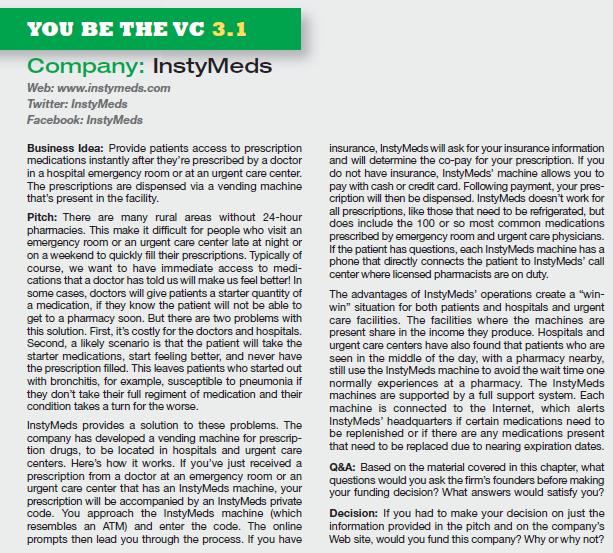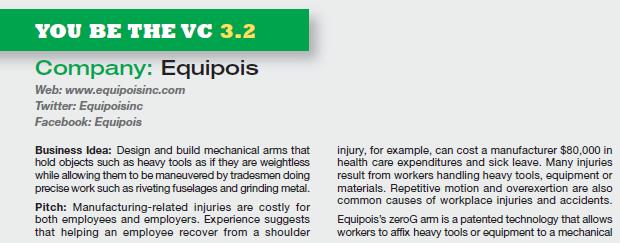One of the challenges business owners have is determining how closely to stick to their business plan
Question:
One of the challenges business owners have is determining how closely to stick to their business plan once the business is launched and they start receiving customer feedback. In almost all cases, some changes will need to be made to each firm’s plan. But the degree to which business plans pan out as their founders envisioned varies. In some cases, a business plan is spot-on and the worst thing a founder could do is vary from the plan. In other cases, a plan needs to be significantly tweaked, and in still other cases it needs to be thrown out the window and the business needs to start over. The following are brief descriptions of businesses that have experienced these various outcomes.
No Changes Needed
Box.net was founded in 2005 by Aaron Levie and Dylan Smith, as one of the first cloud-based Internet platforms.
The company first operated out of Levie’s dorm room, where he and Smith were students in the Marshall School of Business at the University of Southern California. At that time, if you were away from your computer, you had no practical way of accessing the content on your computer’s hard drive. Box.net was founded to solve that problem. The way it works is that users create an account, and are then able to upload content to Box.net’s servers. Once the content is on Box.net’s servers, it can be accessed anywhere the user has access to a computer and an Internet connection.
Box.net pioneered the freemium business model. From the outset, it allowed users to upload a certain amount of content for free, and then charged, on a tier system, for additional data storage. While Box.net has enhanced its service offerings over the years, its basic business plan has remained unchanged. Since 2005, more than 3 million individuals, small businesses, and Fortune 1000 companies have used Box.net’s services.
Minor Changes Needed
Pixability was started by Bettina Hein in October 2008 to help families with home video needs. The idea was that people who shot home videos at family gatherings, like weddings, reunions, and family trips, could send the videos to Pixability, and Pixability would turn the videos into a single polished, movie-quality home video. The company’s clients, who had an average income of more than $250,000, liked what Pixability was doing, but Pixability just couldn’t gain traction and grow. During this time, several businesses asked Pixability if it could do for businesses what it did for families—take amateur shot video and convert it into a polished, finished product. Pixability decided to give this target market a shot, and it worked. Pixability has now repositioned itself as a B2B video editing and production service for businesses. For a base-rate of $795, Pixability will send a business a flip camera, instruct the business to shoot video consistent with the type of marketing message and branding strategy it wants to convey, and will then take the video and fashion it into a polished, professional-looking product that a company can post on YouTube, its Web site, or use in any manner it wishes. Pixability offers additional services on a subscription basis.
Major Changes Needed
Groupon was founded at the beginning of 2007 by Andrew Mason. It started out as ThePoint.com. ThePoint.
com was a broad social network that was built for people who wanted to organize collective action, like raising money for a charitable cause or organizing a protest.
A distinctive aspect of the site was that the collective action would only be initiated if a large enough critical mass of people signed up—making the action worthwhile.
Mason and his team worked on ThePoint.com for nearly two years, but couldn’t find a sustainable revenue model. One thing they noticed that subscribers were using ThePoint.com for was to organize collective buying campaigns. A campaign would be something like “If we can get 100 people to participate, we can all get half-off subscriptions to the New York Times.” Mason and his team liked this idea, but were aware of collective buying sites that launched in the 1990s and failed. They suspected, however, that if a site focused on local deals, rather than consumer goods, which typified the failed sites in the 1990s, it might work. So the business plan for ThePoint.com was abandoned, and Groupon was born.
Groupon is now one of the most talked about companies on the Internet. It is a deal-of-the-day Web site that focuses on offering local deals. As of October 2010, it served 150 markets in North America and 100 markets in Europe, Asia, and South America. It has over 35 million registered users who are sent an e-mail message every morning that features daily deals for their communities.
A distinctive aspect of Groupon’s approach is that a certain number of people must sign up for its service before the deal is “on,” similar to how ThePoint.com operated. A typical Groupon daily deal is a spa that’s offering a 50 percent discount, if a minimum of 200 sign up. The inducement for the spa to offer a 50 percent discount is to acquire new customers.
Questions for Critical Thinking
1. Despite all the changes that have happened with the Internet since 2005, when Box.net was founded, why do you think the company has been able to successfully stick with its original business plan?
2. What do you think would have happened to Pixability if it hadn’t changed its business plan? What do you think would have happened to Groupon if it had not made major changes to its business plan?
3. Why do you think some start-ups find it difficult to change their business plan, even when presented with evidence that their current business plan isn’t working?
4. Look at the “You Be the VC” features at the end of Chapter 3, which focus on InstyMeds and Equipois, and the “You Be the VC” features at the end of this chapter, which focus on SafetyWeb and PharmaJet.
From the information in the features and on each of the company’s Web sites, which company do you think will have the easiest time sticking to its original business plan? Which company do you think will have the hardest time? Explain your selections.


Step by Step Answer:

Entrepreneurship Successfully Launching New Ventures
ISBN: 9780132555524
4th Edition
Authors: Bruce R. Barringer, R. Duane Ireland





